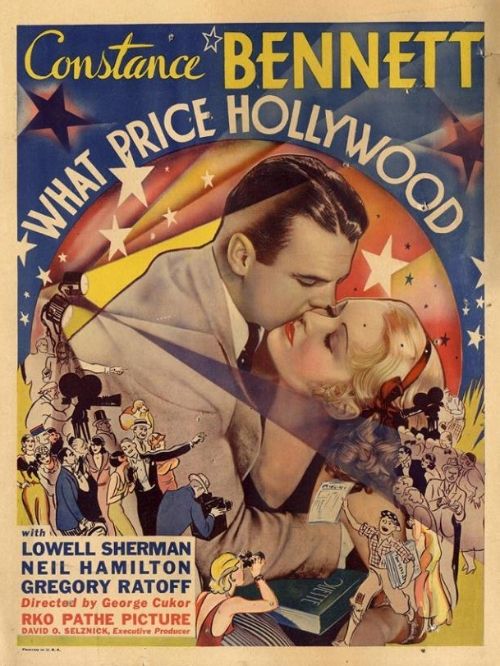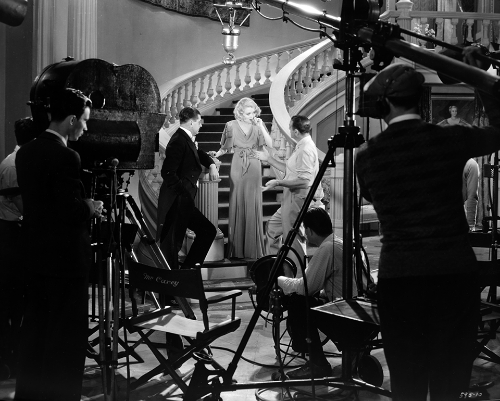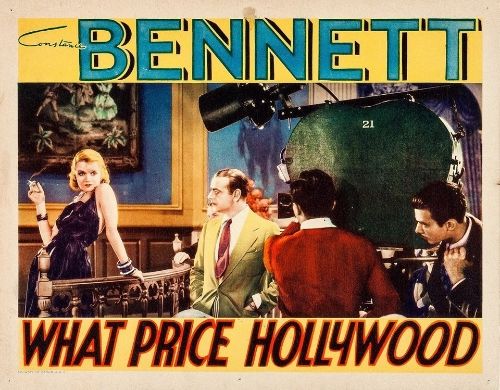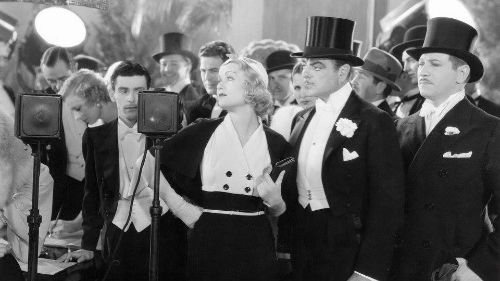The following is a transcript of my presentation on What Price Hollywood?, which was screened at the Park Ridge Public Library on March 23, 2017.
What Price Hollywood? (1932) was one of the first serious films to dramatize the price of movie success. It offered a realistic depiction of the movie business. It’s a movie about stardom that serves as a cautionary tale, and yet, like other films in this sub-genre, it sends mixed signals. It shows the cost of celebrity while also glamorizing Hollywood. Producer David O. Selznick would bring a similar version of this story to the screen with A Star is Born in 1937, and then George Cukor, the director of What Price Hollywood?, would remake A Star is Born in 1954 with Judy Garland and James Mason.
The basic story has become the stuff of legend– the romantic myth of Hollywood as a fabled El Dorado. It’s a movie about getting “the break”—that chance at stardom. Mary Evans, a Brown Derby waitress, gets discovered by Max Carey, an alcoholic director who frequents the restaurant and lives his life as though it were all in fun. On a whim, he takes Mary in a jalopy to a Hollywood premiere at Grauman’s Chinese Theatre. This leads to a screen test for her and then a contract. In due time, her career begins to soar while Carey’s begins to slide. While dealing with the decline of her friend, Mary must also handle the rising pressure from the public that had made her.
Though several writers would work on the screenplay, the original story was by Adela Rogers St. John, who was predominantly a women’s magazine writer. She had based the idea on silent star Colleen Moore, who had been a rising star married to an alcoholic producer. David Selznick’s early version of the story was to be called The Truth About Hollywood. However, it was not intended to be a cynical depiction of the business. Selznick loved Hollywood and wanted to capture the exuberance but also the triumphs and tragedies of those who worked there. He was particularly drawn to the character of Max Carey, a flawed and self-destructive man. This character was said to have also been based on real-life director Marshall Neilan, a well-known alcoholic. In casting the role, it required an actor who could bring a light touch. But the star of What Price Hollywood? would be the actress playing Mary Evans. This was intended for Clara Bow, who might’ve been terrific. Selznick pushed for her in the early stages of the story’s development, but the New York office of RKO determined that she was “through” as an actress.
When it came time to casting, Constance Bennett was the logical choice for Mary Evans. The older sister of Joan Bennett, Constance was one of the biggest stars on the RKO lot and was one of the most popular actresses in the early 1930s. She often played society ladies in melodramas but was adept at light comedy too. Film historian James Robert Parish has a wonderful quote about her in his book The RKO Gals. In it he wrote, “In those early Depression years she was considered the epitome of screen chic, not aristocratic like Norma Shearer or Ina Claire, but sanguine and crisp, a woman to pique the imagination with her long-limbed, fluid figure and those luminous wide eyes accenting a pert face… She was quixotic, turbulent, stubborn, aggressive, theatrical and full of positive guiles, dynamic and dogmatic enough (like her famous actor father, Richard Bennett) to force her will on others without thought of the consequences.”
Today, she is best remembered for her role in Topper opposite Cary Grant. At that time in 1932, Bennett was married to an aristocrat who happened to be one of Gloria Swanson’s ex-husbands. Bennett was a good actress, but it would be Lowell Sherman as Max who would make the film work. It’s the dynamic between the two of them that is so remarkable—a platonic relationship based on mutual respect. Sherman is terrific as the drunk who discovers Mary at the Brown Derby.
Lowell Sherman, who is all but forgotten today, had gotten his start as an actor in the early 1920s working with D. W. Griffith on Way Down East and playing the villain in that film. Sherman also worked behind the camera and later directed She Done Him Wrong with Mae West and Morning Glory with Katherine Hepburn. At the time, he was married to John Barrymore’s sister-in-law, and it’s been suggested that he deliberately brought a John Barrymore flourish to some of his dialogue. Before his early death from pneumonia in 1934, Sherman had made a string of films that had made money. In What Price Hollywood? he brings a self-awareness to the story. As a director himself, there is an authenticity behind his performance which adds to the atmosphere of the production.
No movie about the movies would be complete without the requisite “screen test.” Mary gets hers and fails miserably, only to succeed after hours of practicing and getting another chance. This is always a popular moment in movies that deal with the behind-the-scenes drama. It’s a convention that offers great comedic potential, as we’ve seen in the previous two films of this series.
Halfway through the movie, Mary meets playboy polo player Lonny Borden, played by Neil Hamilton, who is best known to a later generation as Commissioner Gordon in the “Batman” TV series. Considering that Lonny’s courtship of Mary consists of breaking and entering, kidnapping, and force-feeding her over dinner, I’m not sure how well his tactics would be received in 2017. But Lonny has no use for Hollywood, and his presence in the film provides the necessary conflict, if nothing else.
There’s plenty of melodrama and hysterics in the second half, but what redeems the film are its final scenes with Max. When Mary takes him into her home after bailing him out of a drunk tank, there’s a poignant speech he gives about feeling burned out. It’s Sherman’s best scene, and the following sequence is the most shocking in the film. Sherman’s last scene was actually designed by Slavko Vorkapich, who worked closely with George Cukor. Vorkapich was a Yugoslavian genius who excelled in movie montages. Note the stylization and rhythm of the sequence.
What Price Hollywood? is a classic example of a cautionary tale with a conflicted message. The wonderful opening, in which Mary Evans is imitating the style of the Hollywood stars by comparing herself to what she sees in print, shows the glamor associated with the movies. She identifies with the star and we identify with her. This is conveyed through the fan magazines, which can captivate the imagination of the typical moviegoer. There is some irony here considering Constance Bennett was herself one of the great fashion icons who had graced the covers of many of these magazines. At that time, Hollywood exerted a hold on its fans that will never be duplicated.
Mary stares into the mirror and sees her aspirations reflected back, but the mirror also shows us the opposite effect, what fame looks like when it’s burned out. One of the memorable images in the movie comes near the climax when Max looks at himself in the mirror and he compares what he sees to a framed picture of himself in his younger days. Here, the mirror shows us his failure.
What Price Hollywood? was a critical and financial success, although David Selznick always felt the story contrivances got in the way of the larger image he wanted to present of Hollywood. Five years later, Selznick produced A Star is Born with William Wellman directing. Janet Gaynor played the small-town girl who dreams of coming to Hollywood. This time, the husband and director roles in What Price Hollywood? were fused into one character: actor Norman Maine, played by Fredric March. A Star is Born would garner several Academy Award nominations. The 1937 film will be screened next week.
~MCH





